The Microstructures, Mechanical Properties, and Deformation Mechanism of B2-Hardened NbTiAlZr-Based Refractory High-Entropy Alloys
Abstract
:1. Introduction
2. Materials and Methods
3. Results and Discussion
4. Conclusions
- (1)
- The RHEAs exhibit an excellent combination of high yield strength, low density (7.41~7.51 g/cm3), and large plasticity (ε > 0.35) at RT. The SYSs of the NbTiAl-3 RHEA are ~131 MPa·cm3/g at 1023 K and ~104.2 MPa·cm3/g at 1123 K, respectively, which are far superior to most typical RHEAs. These excellent mechanical properties are mainly attributed to the solid solution strengthening induced by the Zr element.
- (2)
- The deformation of the NbTiAl-3 RHEA at 298 K is dominated by the planar slip of dislocations, resulting in two dislocation slip bands oriented in the [111](10) and [111](11) directions. Dislocation pile-up in the slip bands and the two types of slip bands interact continually, providing considerable plastic deformation capability.
- (3)
- The DRX formed at GBs and low dislocation density inside the grains induced via dislocation annihilation accelerate continuous strain softening after yielding during the 1123 K compression of the NbTiAl-3 RHEA.
Author Contributions
Funding
Institutional Review Board Statement
Informed Consent Statement
Data Availability Statement
Conflicts of Interest
References
- Pollock, T.M.; Tin, S. Nickel-Based Superalloys for Advanced Turbine Engines: Chemistry, Microstructure and Properties. J. Propuls. Power 2006, 22, 361–374. [Google Scholar] [CrossRef]
- Senkov, O.N.; Miracle, D.B.; Chaput, K.J.; Couzinie, J.-P. Development and exploration of refractory high entropy alloys—A review. J. Mater. Res. 2018, 33, 3092–3128. [Google Scholar] [CrossRef]
- Hua, X.-J.; Hu, P.; Xing, H.-R.; Han, J.-Y.; Ge, S.-W.; Li, S.-L.; He, C.-J.; Wang, K.-S.; Cui, C.-J. Development and Property Tuning of Refractory High-Entropy Alloys: A Review. Acta Metall. Sin. 2022, 35, 1231–1265. [Google Scholar] [CrossRef]
- Senkov, O.N.; Wilks, G.B.; Scott, J.M.; Miracle, D.B. Mechanical properties of Nb25Mo25Ta25W25 and V20Nb20Mo20Ta20W20 refractory high entropy alloys. Intermetallics 2011, 19, 698–706. [Google Scholar] [CrossRef]
- Han, Z.D.; Chen, N.; Zhao, S.F.; Fan, L.W.; Yang, G.N.; Shao, Y.; Yao, K.F. Effect of Ti additions on mechanical properties of NbMoTaW and VNbMoTaW refractory high entropy alloys. Intermetallics 2017, 84, 153–157. [Google Scholar] [CrossRef]
- Yi, J.; Cao, F.; Xu, M.; Yang, L.; Wang, L.; Zeng, L. Phase, microstructure and compressive properties of refractory high-entropy alloys CrHfNbTaTi and CrHfMoTaTi. Int. J. Miner. Metall. Mater. 2022, 29, 1231–1236. [Google Scholar] [CrossRef]
- Senkov, O.N.; Scott, J.M.; Senkova, S.V.; Meisenkothen, F.; Miracle, D.B.; Woodward, C.F. Microstructure and elevated temperature properties of a refractory TaNbHfZrTi alloy. J. Mater. Sci. 2012, 47, 4062–4074. [Google Scholar] [CrossRef]
- Wang, M.; Ma, Z.L.; Xu, Z.Q.; Cheng, X.W. Effects of vanadium concentration on mechanical properties of VxNbMoTa refractory high-entropy alloys. Mater. Sci. Eng. A 2021, 808, 140848. [Google Scholar] [CrossRef]
- Pang, J.; Zhang, H.; Zhang, L.; Zhu, Z.; Fu, H.; Li, H.; Wang, A.; Li, Z.; Zhang, H. A ductile Nb40Ti25Al15V10Ta5Hf3W2 refractory high entropy alloy with high specific strength for high-temperature applications. Mater. Sci. Eng. A 2022, 831, 142290. [Google Scholar] [CrossRef]
- Eleti, R.R.; Bhattacharjee, T.; Shibata, A.; Tsuji, N. Unique deformation behavior and microstructure evolution in high temperature processing of HfNbTaTiZr refractory high entropy alloy. Acta Mater. 2019, 171, 132–145. [Google Scholar] [CrossRef]
- Eleti, R.R.; Chokshi, A.H.; Shibata, A.; Tsuji, N. Unique high-temperature deformation dominated by grain boundary sliding in heterogeneous necklace structure formed by dynamic recrystallization in HfNbTaTiZr BCC refractory high entropy alloy. Acta Mater. 2020, 183, 64–77. [Google Scholar] [CrossRef]
- Jia, Y.; Wang, G.; Wu, S.; Mu, Y.; Yi, Y.; Jia, Y.; Liaw, P.K.; Zhang, T.; Liu, C.-T. A lightweight refractory complex concentrated alloy with high strength and uniform ductility. Appl. Mater. Today 2022, 27, 101429. [Google Scholar] [CrossRef]
- Pang, J.; Xiong, T.; Wei, X.; Zhu, Z.; Zhang, B.; Zhou, Y.; Shao, X.; Jin, Q.; Zheng, S.; Ma, X. Oxide MnCr2O4 induced pitting corrosion in high entropy alloy CrMnFeCoNi. Materialia 2019, 6, 100275. [Google Scholar] [CrossRef]
- An, Z.; Mao, S.; Liu, Y.; Wang, L.; Zhou, H.; Gan, B.; Zhang, Z.; Han, X. A novel HfNbTaTiV high-entropy alloy of superior mechanical properties designed on the principle of maximum lattice distortion. J. Mater. Sci. Technol. 2021, 79, 109–117. [Google Scholar] [CrossRef]
- Senkov, O.N.; Wilks, G.B.; Miracle, D.B.; Chuang, C.P.; Liaw, P.K. Refractory high-entropy alloys. Intermetallics 2010, 18, 1758–1765. [Google Scholar] [CrossRef]
- Feng, R.; Zhang, C.; Gao, M.C.; Pei, Z.; Zhang, F.; Chen, Y.; Ma, D.; An, K.; Poplawsky, J.D.; Ouyang, L.; et al. High-throughput design of high-performance lightweight high-entropy alloys. Nat. Commun. 2021, 12, 4329. [Google Scholar] [CrossRef]
- Qiao, D.; Liang, H.; Wu, S.; He, J.; Cao, Z.; Lu, Y.; Li, T. The mechanical and oxidation properties of novel B2-ordered Ti2ZrHf0.5VNb0.5Alx refractory high-entropy alloys. Mater. Charact. 2021, 178, 111287. [Google Scholar] [CrossRef]
- Chen, H.; Kauffmann, A.; Seils, S.; Boll, T.; Liebscher, C.H.; Harding, I.; Kumar, K.S.; Szabó, D.V.; Schlabach, S.; Kauffmann-Weiss, S.; et al. Crystallographic ordering in a series of Al-containing refractory high entropy alloys Ta–Nb–Mo–Cr–Ti–Al. Acta Mater. 2019, 176, 123–133. [Google Scholar] [CrossRef]
- Soni, V.; Gwalani, B.; Alam, T.; Dasari, S.; Zheng, Y.; Senkov, O.N.; Miracle, D.; Banerjee, R. Phase Inversion in a Two-phase, BCC+B2, Refractory High Entropy Alloy. Acta Mater. 2019, 185, 89–97. [Google Scholar] [CrossRef]
- Soni, V.; Senkov, O.N.; Gwalani, B.; Miracle, D.B.; Banerjee, R. Microstructural Design for Improving Ductility of An Initially Brittle Refractory High Entropy Alloy. Sci. Rep. 2018, 8, 8816. [Google Scholar] [CrossRef]
- Pang, J.; Zhang, H.; Ji, Y.; Zhu, Z.; Zhang, L.; Li, H.; Wang, A.; Zhang, H. High-temperature structural and mechanical stability of refractory high-entropy alloy Nb40Ti25Al15V10Ta5Hf3W2. Mater. Charact. 2023, 205, 113321. [Google Scholar] [CrossRef]
- Yurchenko, N.; Panina, E.; Tojibaev, A.; Novikov, V.; Salishchev, G.; Zherebtsov, S.; Stepanov, N. Effect of B2 ordering on the tensile mechanical properties of refractory AlxNb40Ti40V20−x medium-entropy alloys. J. Alloys Compd. 2023, 937, 168465. [Google Scholar] [CrossRef]
- Yurchenko, N.; Panina, E.; Tojibaev, A.; Novikov, V.; Salishchev, G.; Zherebtsov, S.; Stepanov, N. Tuning the grain and domain sizes to achieve superior room-temperature tensile ductility in a B2-ordered refractory Al15Nb40Ti40V5 medium-entropy alloy. Mater. Sci. Eng. A 2023, 874, 145073. [Google Scholar] [CrossRef]
- Yurchenko, N.Y.; Stepanov, N.D.; Zherebtsov, S.V.; Tikhonovsky, M.A.; Salishchev, G.A. Structure and mechanical properties of B2 ordered refractory AlNbTiVZrx (x = 0–1.5) high-entropy alloys. Mater. Sci. Eng. A 2017, 704, 82–90. [Google Scholar] [CrossRef]
- Zhang, Y.; Liu, J.P.; Chen, S.Y.; Xie, X.; Liaw, P.K.; Dahmen, K.A.; Qiao, J.W.; Wang, Y.L. Serration and noise behaviors in materials. Prog. Mater. Sci. 2017, 90, 358–460. [Google Scholar] [CrossRef]
- Ge, S.; Fu, H.; Zhang, L.; Mao, H.; Li, H.; Wang, A.; Li, W.; Zhang, H. Effects of Al addition on the microstructures and properties of MoNbTaTiV refractory high entropy alloy. Mater. Sci. Eng. A 2020, 784, 139275. [Google Scholar] [CrossRef]
- Toda-Caraballo, I.; Rivera-Diaz-del-Castillo, P.E.J. Modelling solid solution hardening in high entropy alloys. Acta Mater. 2015, 85, 14–23. [Google Scholar] [CrossRef]
- Li, Q.Y.; Zhang, H.; Li, D.C.; Chen, Z.H.; Huang, S.; Lu, Z.L.; Yan, H.Q. WxNbMoTa Refractory High-Entropy Alloys Fabricated by Laser Cladding Deposition. Materials 2019, 12, 533. [Google Scholar] [CrossRef]
- Chen, Y.; Li, Y.; Cheng, X.; Wu, C.; Cheng, B.; Xu, Z. The Microstructure and Mechanical Properties of Refractory High-Entropy Alloys with High Plasticity. Materials 2018, 11, 208. [Google Scholar] [CrossRef]
- Senkov, O.N.; Woodward, C.; Miracle, D.B. Microstructure and Properties of Aluminum-Containing Refractory High-Entropy Alloys. Jom 2014, 66, 2030–2042. [Google Scholar] [CrossRef]
- Tseng, K.-K.; Juan, C.-C.; Tso, S.; Chen, H.-C.; Tsai, C.-W.; Yeh, J.-W. Effects of Mo, Nb, Ta, Ti, and Zr on Mechanical Properties of Equiatomic Hf-Mo-Nb-Ta-Ti-Zr Alloys. Entropy 2019, 21, 15. [Google Scholar] [CrossRef]
- Senkov, O.N.; Senkova, S.V.; Miracle, D.B.; Woodward, C. Mechanical properties of low-density, refractory multi-principal element alloys of the Cr–Nb–Ti–V–Zr system. Mater. Sci. Eng. A 2013, 565, 51–62. [Google Scholar] [CrossRef]
- Senkov, O.N.; Senkova, S.V.; Woodward, C.; Miracle, D.B. Low-density, refractory multi-principal element alloys of the Cr–Nb–Ti–V–Zr system: Microstructure and phase analysis. Acta Mater. 2013, 61, 1545–1557. [Google Scholar] [CrossRef]
- Juan, C.-C.; Tseng, K.-K.; Hsu, W.-L.; Tsai, M.-H.; Tsai, C.-W.; Lin, C.-M.; Chen, S.-K.; Lin, S.-J.; Yeh, J.-W. Solution strengthening of ductile refractory HfMoxNbTaTiZr high-entropy alloys. Mater. Lett. 2016, 175, 284–287. [Google Scholar] [CrossRef]
- Guo, W.; Liu, B.; Liu, Y.; Li, T.; Fu, A.; Fang, Q.; Nie, Y. Microstructures and mechanical properties of ductile NbTaTiV refractory high entropy alloy prepared by powder metallurgy. J. Alloys Compd. 2019, 776, 428–436. [Google Scholar] [CrossRef]
- Xu, Z.Q.; Ma, Z.L.; Wang, M.; Chen, Y.W.; Tan, Y.D.; Cheng, X.W. Design of novel low-density refractory high entropy alloys for high-temperature applications. Mater. Sci. Eng. A 2019, 755, 318–322. [Google Scholar] [CrossRef]
- Thirathipviwat, P.; Song, G.; Jayaraj, J.; Bednarcik, J.; Wendrock, H.; Gemming, T.; Freudenberger, J.; Nielsch, K.; Han, J. A comparison study of dislocation density, recrystallization and grain growth among nickel, FeNiCo ternary alloy and FeNiCoCrMn high entropy alloy. J. Alloys Compd. 2019, 790, 266–273. [Google Scholar] [CrossRef]
- Williamson, G.K.; Smallman, R.E., III. Dislocation densities in some annealed and cold-worked metals from measurements on the X-ray debye-scherrer spectrum. Philos. Mag. A J. Theor. Exp. Appl. Phys. 1956, 1, 34–46. [Google Scholar] [CrossRef]
- Jiang, J.; Britton, T.B.; Wilkinson, A.J. Evolution of dislocation density distributions in copper during tensile deformation. Acta Mater. 2013, 61, 7227–7239. [Google Scholar] [CrossRef]
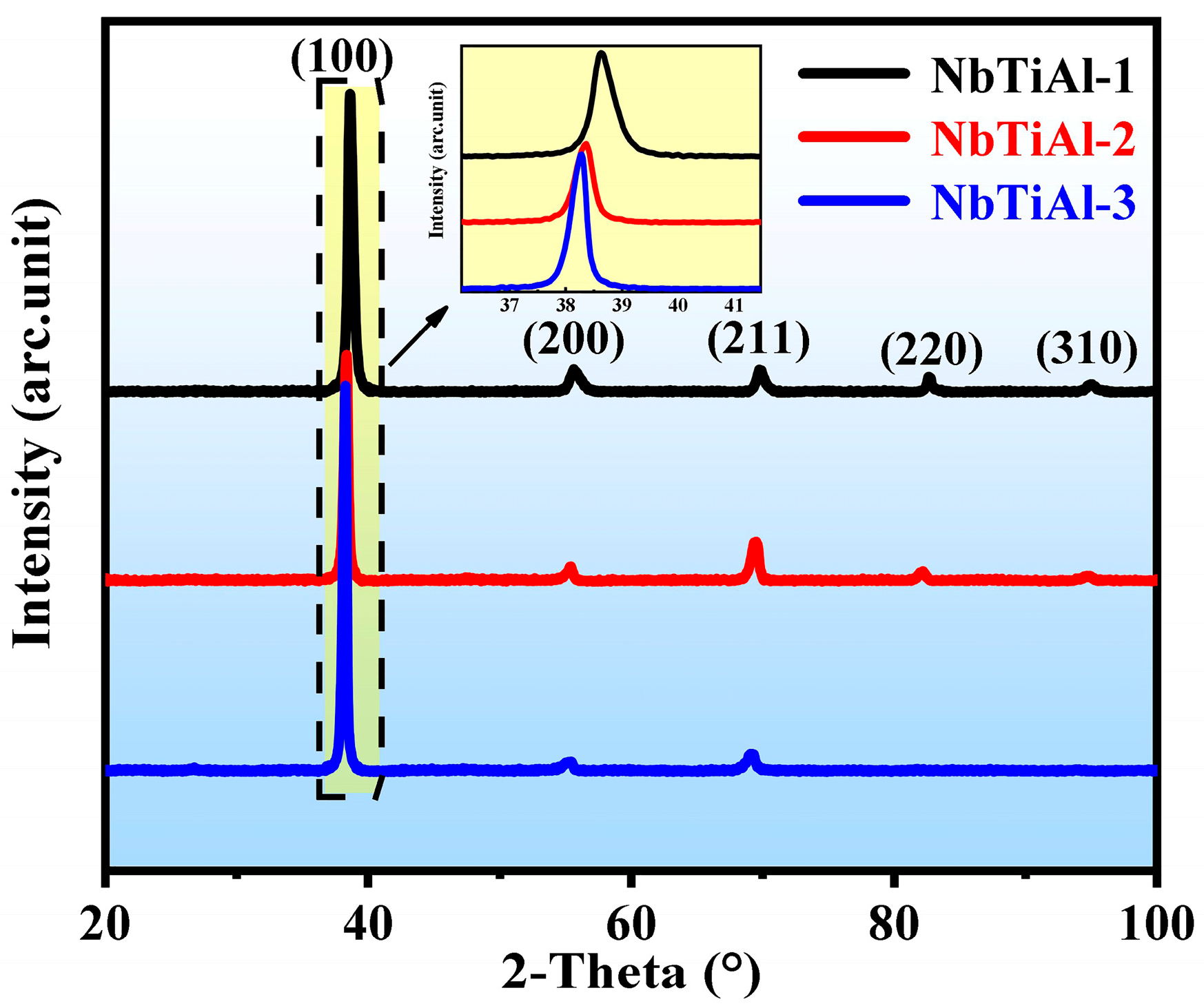

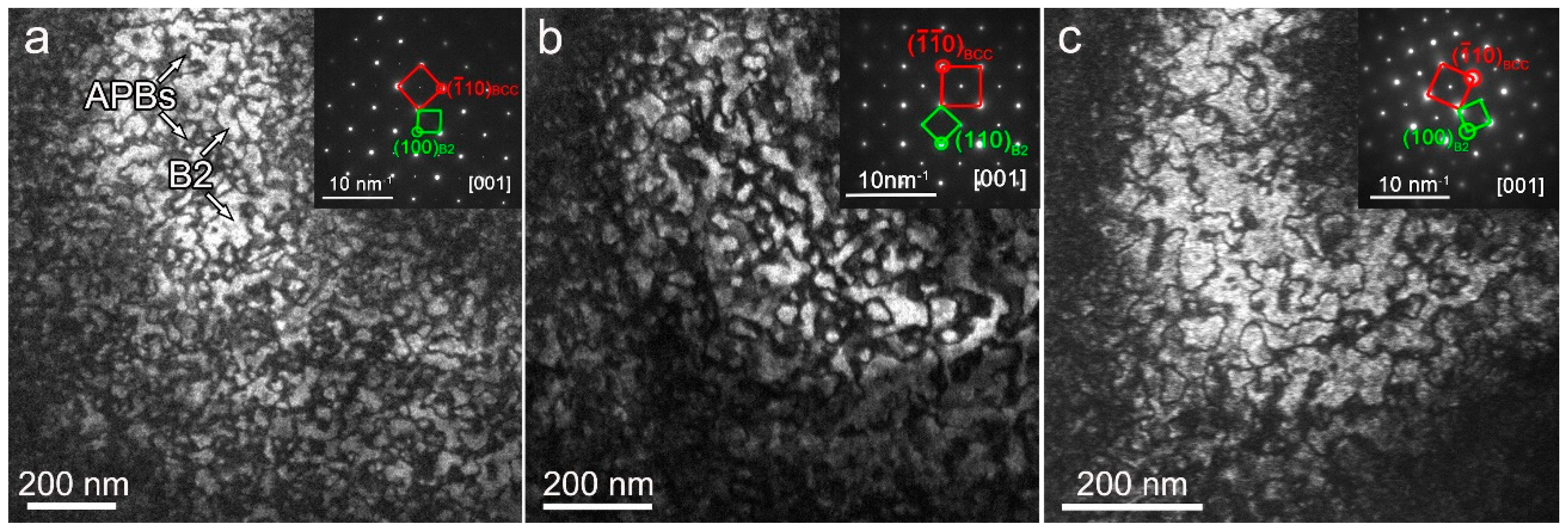
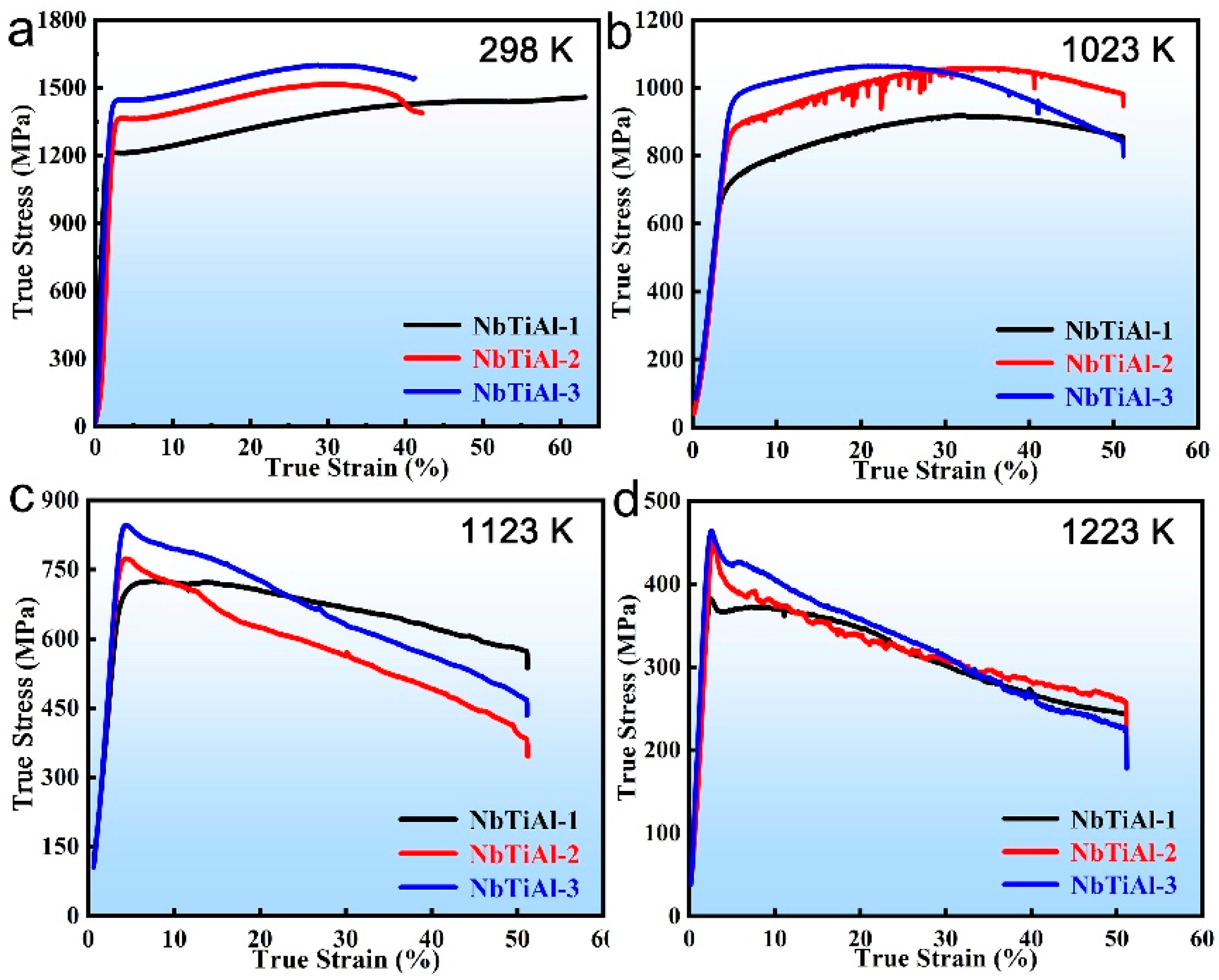
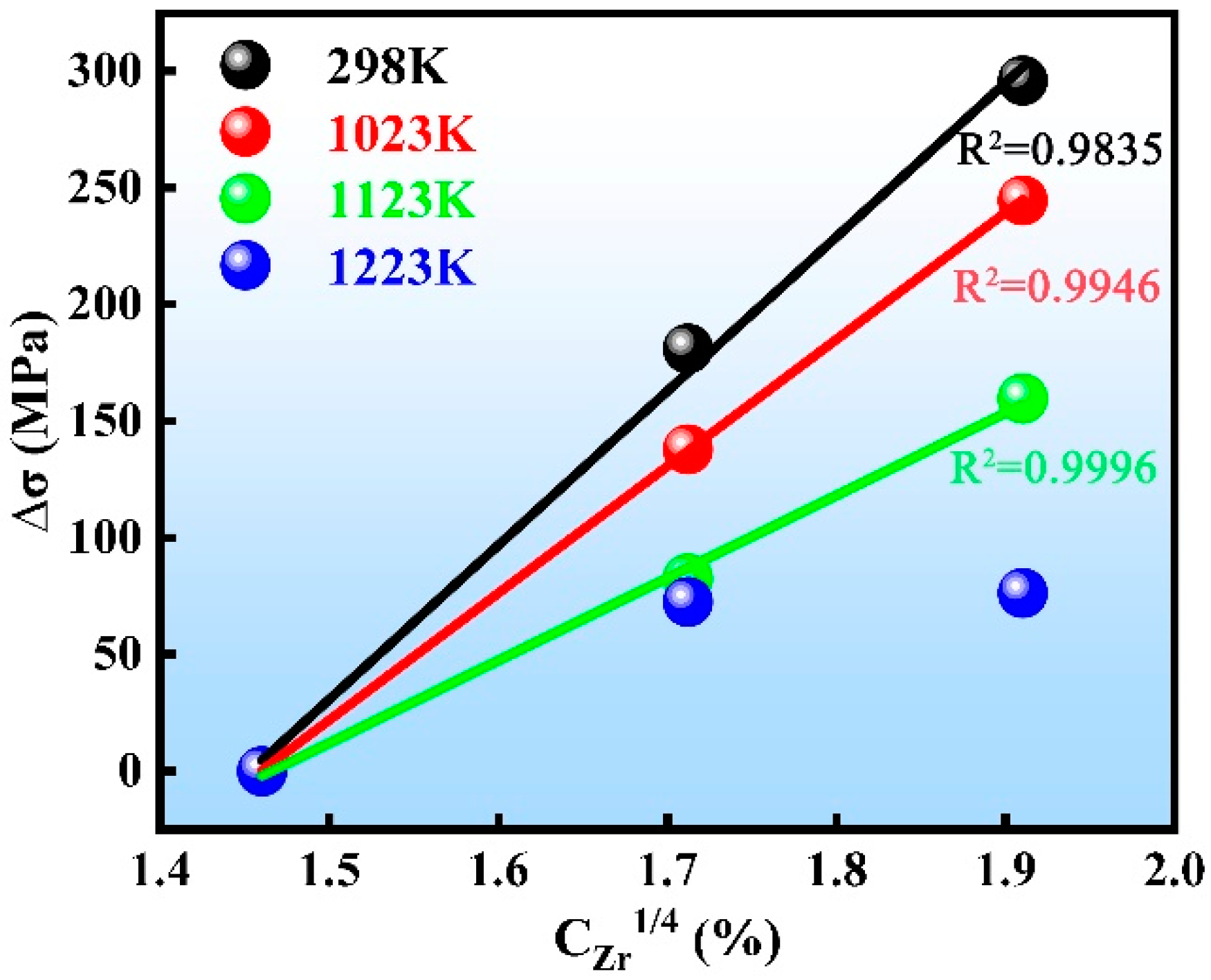

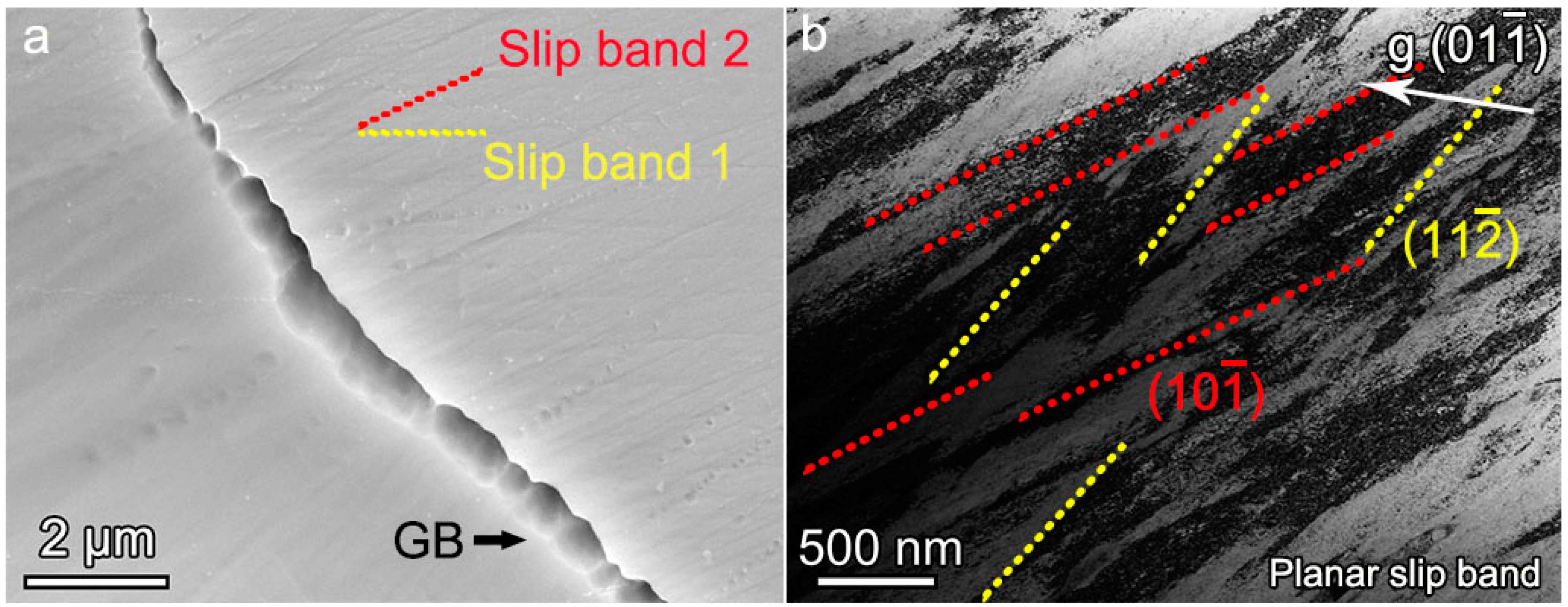
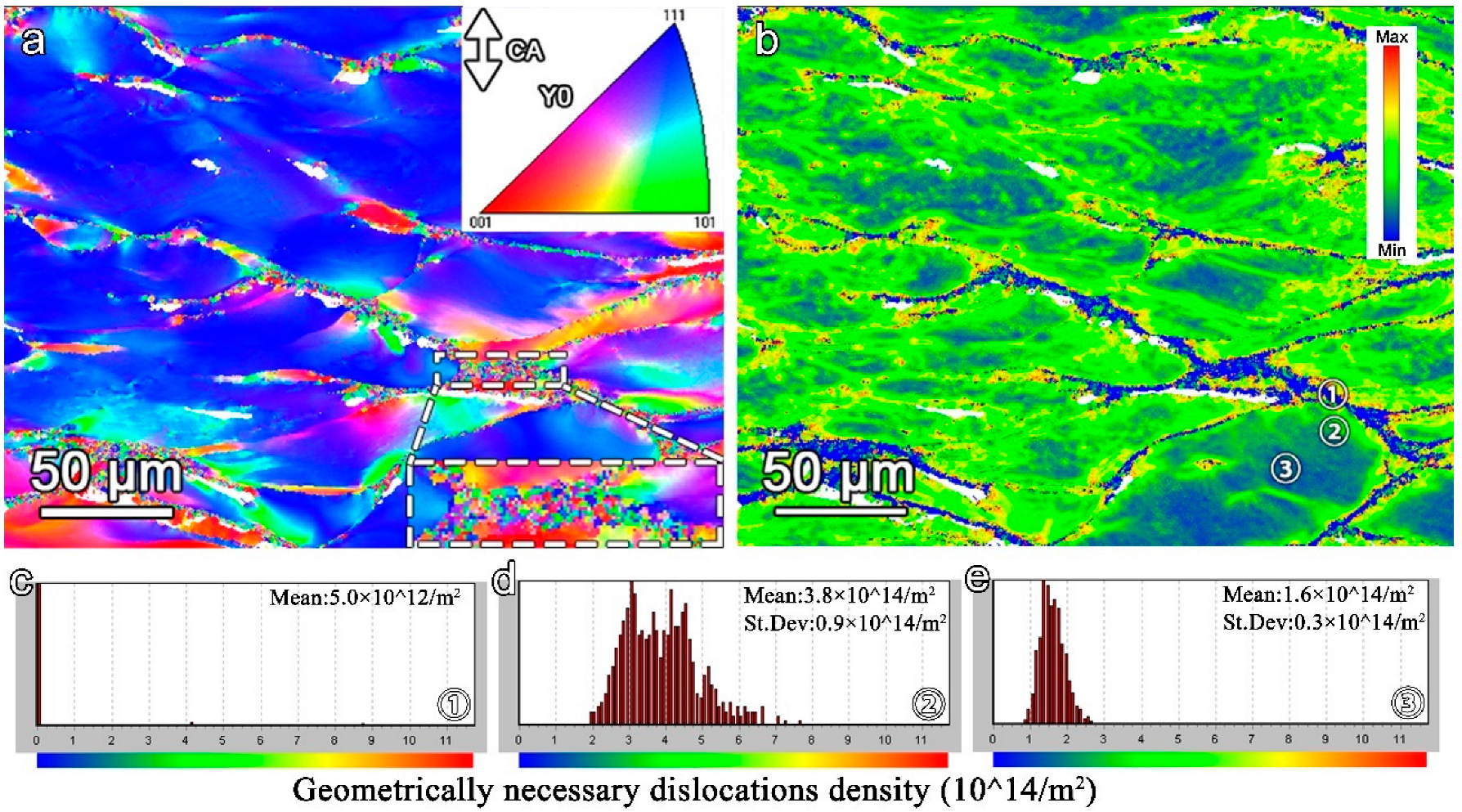
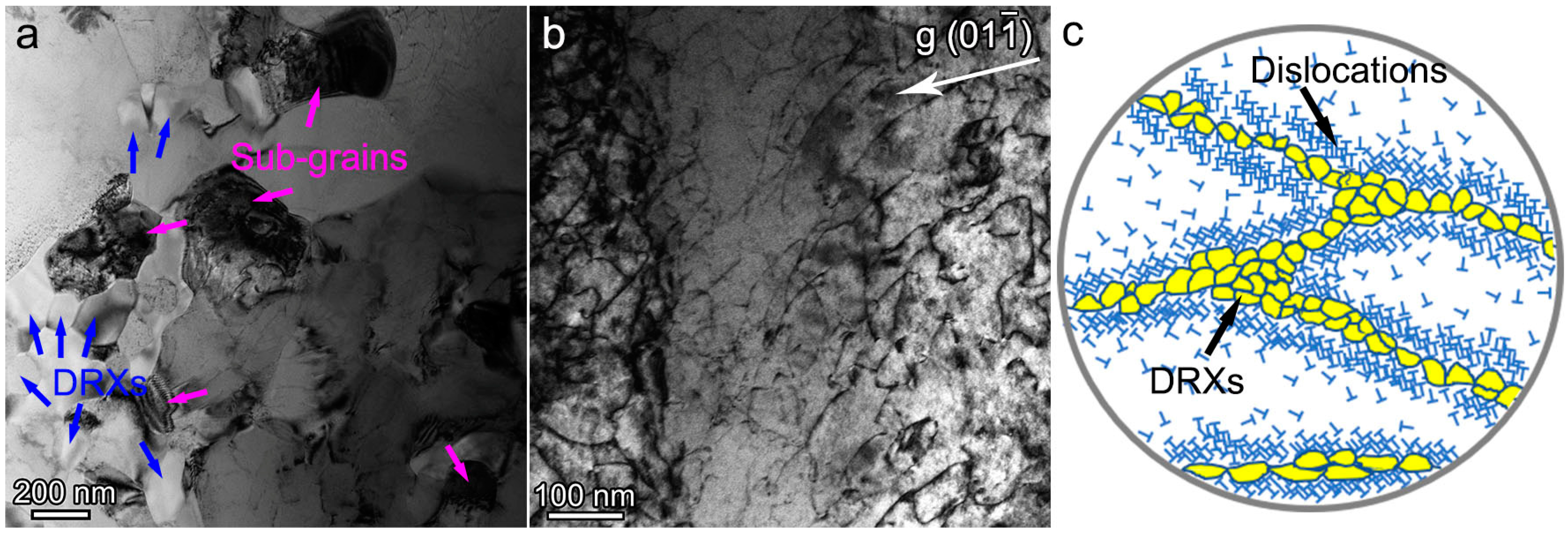
| Nominal Composition | Nb | Ti | Al | Zr | Hf | Ta | Mo | W |
|---|---|---|---|---|---|---|---|---|
| Nb42Ti25Al15Zr5Hf5Ta5Mo2W1 | 41.2 | 25.7 | 14.3 | 4.6 | 5.2 | 6.0 | 1.4 | 1.6 |
| Nb39Ti23Al15Zr10Hf5Ta5Mo2W1 | 40.4 | 23.7 | 13.6 | 8.6 | 5.1 | 5.8 | 1.1 | 1.7 |
| Nb37Ti20Al15Zr15Hf5Ta5Mo2W1 | 37.7 | 20.3 | 14.1 | 13.5 | 5.3 | 6.2 | 1.8 | 1.0 |
| Temperature (K) | 298 | 1023 | 1123 | 1223 | |
|---|---|---|---|---|---|
| NbTiAl-1 | σYS | 1198.1 ± 7.5 | 705.6 ± 12.8 | 705.5 ± 12.5 | 386.2 ± 9.2 |
| σYS/ρ | 159.5 | 93.9 | 93.9 | 51.4 | |
| NbTiAl-2 | σYS | 1333.1 ± 7.2 | 857.9 ± 13.1 | 764.6 ± 12.7 | 451.8 ± 11 |
| σYS/ρ | 179.1 | 115.3 | 102.7 | 60.7 | |
| NbTiAl-3 | σYS | 1418.1 ± 7.4 | 951.8 ± 11.5 | 835.5 ± 13 | 466.3 ± 11.4 |
| σYS/ρ | 191.3 | 128.4 | 112.7 | 62.9 |
Disclaimer/Publisher’s Note: The statements, opinions and data contained in all publications are solely those of the individual author(s) and contributor(s) and not of MDPI and/or the editor(s). MDPI and/or the editor(s) disclaim responsibility for any injury to people or property resulting from any ideas, methods, instructions or products referred to in the content. |
© 2023 by the authors. Licensee MDPI, Basel, Switzerland. This article is an open access article distributed under the terms and conditions of the Creative Commons Attribution (CC BY) license (https://creativecommons.org/licenses/by/4.0/).
Share and Cite
Tang, G.; Shao, X.; Pang, J.; Ji, Y.; Wang, A.; Li, J.; Zhang, H.; Zhang, H. The Microstructures, Mechanical Properties, and Deformation Mechanism of B2-Hardened NbTiAlZr-Based Refractory High-Entropy Alloys. Materials 2023, 16, 7592. https://doi.org/10.3390/ma16247592
Tang G, Shao X, Pang J, Ji Y, Wang A, Li J, Zhang H, Zhang H. The Microstructures, Mechanical Properties, and Deformation Mechanism of B2-Hardened NbTiAlZr-Based Refractory High-Entropy Alloys. Materials. 2023; 16(24):7592. https://doi.org/10.3390/ma16247592
Chicago/Turabian StyleTang, Guangquan, Xu Shao, Jingyu Pang, Yu Ji, Aimin Wang, Jinguo Li, Haifeng Zhang, and Hongwei Zhang. 2023. "The Microstructures, Mechanical Properties, and Deformation Mechanism of B2-Hardened NbTiAlZr-Based Refractory High-Entropy Alloys" Materials 16, no. 24: 7592. https://doi.org/10.3390/ma16247592
APA StyleTang, G., Shao, X., Pang, J., Ji, Y., Wang, A., Li, J., Zhang, H., & Zhang, H. (2023). The Microstructures, Mechanical Properties, and Deformation Mechanism of B2-Hardened NbTiAlZr-Based Refractory High-Entropy Alloys. Materials, 16(24), 7592. https://doi.org/10.3390/ma16247592





